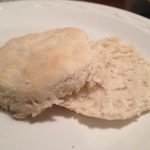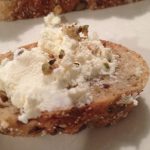Early on in the planning stages for this project, we came to the conclusion that in order to really connect and understand something, you have to physically connect to it somehow. For us, this meant getting out hands dirty. We picked six cookbooks from the larger collection in order to incorporate as much of the full collection as possible. Unlike the community cookbooks, these cookbooks are a mix of commercial, personal, and storytellers. However, the recipes we picked to recreate are ones that repeated in many of the cookbooks we looked at. Of note is that most of the recipes in the Foothills and Tupelo Honey cookbooks were too involved or expensive for us to be able to make easily on a school night. We compensated for this by picking easier recipes that were in the spirit of those that we could not incorporate. While we wished that we could have cooked more, time, money, and kitchen space worked against us. Please enjoy the write-ups on each of the recipes, the gallery which features documentation of the finished products, and the subpages which contain blurbs about the cookbooks used here.
Buttermilk Biscuits: Buttermilk biscuits are to the South what crab cakes are to the Chesapeake Bay, MD in that it is impossible to think of one without thinking about the other. Both foods are iconic and fall into the category of being a stereotype and a reality. Yet if we’re talking about biscuits, we need to question whose biscuits are in question, because almost every family is going to have a different recipe (and they’re going to think it is the best). Dakota is no exception, and given that all of the recipes have the same base—flour, buttermilk, lard/shortening— we decided to go with her Great Grandmother’s recipe. We know that we originally stated that we wanted to use solely recipes out of the cookbooks, but all projects evolve and this was a great opportunity to mix our research and personal experience. The biscuits turned out well, if a little short, which is due to rolling the dough out a bit thin. Finally, this recipe is how we named this page, and if you’ve never made homemade biscuits before then you should so you have a deeper understanding of how much flour is involved.
Strawberry Freezer Jam: The art of preserving food to be used throughout the year is one critical to the South, especially our mountain region. We wanted one of the recipes to pay homage to this long tradition and thought the apple butter recipe from Blackberry Farm would be a nice addition to the list. However, it quickly became clear that we did not possess the time nor the requisite kitchen equipment to make this recipe or most of the other ones that involved some form of preservation. Our next plan of attack became to use a recipe that celebrated the spirit of the tradition while making use of another recipe from Dakota’s childhood: strawberry freezer jam. The recipe is a lot less hassle than traditional canning and while it might not be as exciting as regular jam, it still tastes likes summer.
Bread & Cheese: This may not seem like a recipe per se, but it was a staple that we kept coming across. All of the cookbooks had at least one or two appetizers that were some sort of bread and cheese combination. While there was no cooking involved, it did give us an excellent excuse to work in the North Asheville Tailgate Farmer’s Market to our project. The Tailgate Farmers Market takes place almost every Saturday from April to October on the UNC Asheville campus. It is an excellent resource for both the campus and the larger community. The cheese used in this project was purchased from Three Grace’s Dairy, one of the regular vendors at the market, and it is everything goat cheese should be: full of flavor and riding the line between creamy and crumbly. We also wanted to pick up bread from Wake Robin Farm, but arrived too late in the morning to make that a reality. Instead we picked up a harvest loaf at one of our grocery stores.
Chicken Salad: This is honestly a recipe that we were not expecting to find over and over again as neither of us think chicken salad when we think of this region. After making the version we did though, neither of us is complaining. The recipe we used came from the Best of the Best cookbook. It is a wonderful blend of sweet and savory created from pulled chicken, mayonnaise, craisins (dried cranberries), walnuts, celery, and fresh chives. Initially the recipe called for pine nuts rather than walnuts, but given that pine nuts can be a tad pricey, we decided against it. We had both seen similar substitutions in our personal food experiences and were sure that chopped walnuts would work just fine.
Strawberry Sodas: This is the final cookbook recipe, chosen because it is a drink, it is a dessert, and we both love strawberries! It should be noted that this recipe is a little more indulgent than everyday, which makes sense considering we pulled this out of the Southern Living Cookbook (one of the more commercial cookbooks). The recipe calls for crushed strawberries, cream soda, strawberry ice cream, whipped cream, and fresh strawberries. Seeing as the recipe is designed for four people and we split it between three, the sodas turned out more like smoothies but were still delicious. In addition, we made homemade whipped cream which always makes everything that much better.
Note: In addition to these recipes, we made sausage gravy (milk, sausage, and flour with seasoning) to go with the biscuits. However given that this was an addition that did not hail from our region we did not include it with the rest.
“Home.” Wake Robin Farm. Accessed 18 April 2017. https://wakerobinfarm.wordpress.com.
McKee, Gwen, and Barbara Moseley, eds. Best of the Best from North Carolina Cookbook: Selected Recipes from North Carolina’s Favorite Cookbooks. Best of the Best Cookbook Series. Quail Ridge Press, 2006.
“Our Story.” Three Graces Dairy Farmstead Cheese. Accessed 18 April 2017. http://www.3gracesdairy.com/ourstory.html.
Payne, Susan Carlisle. The Southern Living Cookbook. Oxmoor House Inc, 1987.
“Welcome.” North Asheville Tailgate Market. Accessed 18 April 2017. http://www.northashevilletailgatemarket.com.










